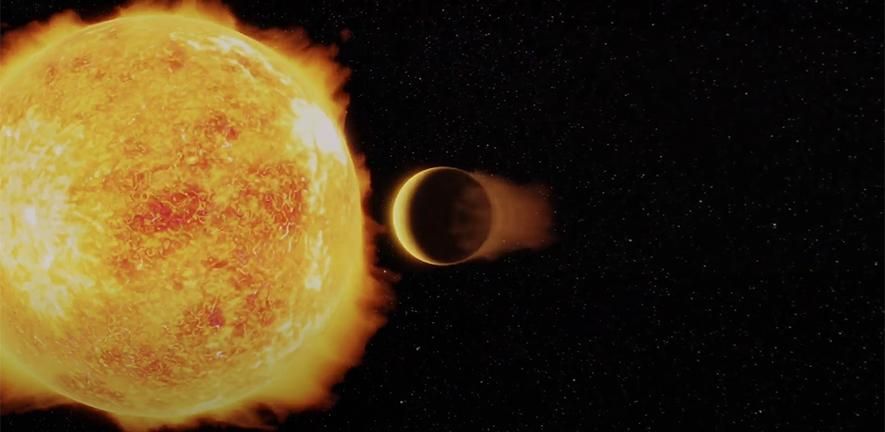'Ultrahot Neptune' discovered around sunlike star

Astronomers have discovered a new type of alien world — the first known "ultrahot Neptune," a giant planet that orbits its star 60 times closer than Earth does the sun, a new study finds.
Previous research found that about 1 in 200 sunlike stars possesses a planet that circles its star so tightly that it orbits in less than one Earth day. Astronomers call these worlds "ultra-short-period planets." (In contrast, Earth takes slightly more than 365 days to circle the sun; Mercury, our sun's closest planet, takes less than 88 days to complete its year.)
All previously known ultra-short-period planets were either rocky planets less than twice Earth's width or so-called hot Jupiters, gas giants sizing in at more than 10 times Earth's diameter. Mysteriously, scientists haven't found many ultra-short-period planets of intermediate size, a phenomenon dubbed the "hot Neptune desert" because Neptune lies between Earth and Jupiter in size.
Now, scientists have discovered an exoplanet that sits right in the hot Neptune desert. But this planet is much hotter than any hot Neptune discovered yet, enough so for researchers to dub it "ultrahot."
Related: The strangest alien planets in pictures
Astronomers used NASA's Transiting Exoplanet Survey Satellite (TESS) to analyze the bright, sunlike star LTT 9779, located about 260 light-years from Earth. Followup observations with other telescopes helped confirm the existence of an exoplanet around this star. This newfound world, dubbed LTT 9779 b, has about 4.7 times Earth's diameter and 29 times Earth's mass.
LTT 9779 b zips around its star about every 19 hours, orbiting its star about 23 times closer than Mercury does the sun, with the star heating it to temperatures of about 3,100 degrees Fahrenheit (1,700 degrees Celsius). In a paper reporting the finding, scientists argued this exoplanet was not just a hot Neptune, but an ultrahot Neptune. (A regular hot Neptune might only get as hot as about 2,240 degrees F (1,225 degrees C), study lead author James Jenkins, an astronomer at the University of Chile in Las Condes, told Space.com.)
The ultrahot temperatures on LTT 9779 b can break molecules down to their constituent elements and ionize metals in its atmosphere. This means its atmosphere "can be very different from just 'hot' planets," Jenkins said, "making them exciting laboratories to study the chemistries of planets."
The newfound exoplanet's average density is much like that of Neptune. The researchers suggested it was unlikely that LTT 9779 b was made of pure rock or pure water — instead, they proposed a solid core surrounded by a hydrogen and helium atmosphere.
Related: 'Smoking gun' planet: This Neptune-size alien world is evaporating in record time
Mysteriously, LTT 9779 b still appears to possess a thick atmosphere, one consisting of nearly 10% of its mass, or equal to about 2.6 times Earth's mass, Jenkins said. One would expect ultrahot Neptunes "to lose their atmospheres very early due to the high-energy radiation received from the star, so for this planet we must think about more exotic types of formation scenarios," Jenkins said.
One possible explanation for this ultrahot Neptune's thick atmosphere "is that the planet was originally much larger, maybe a gas giant like Jupiter, that migrated too close to the star," Jenkins said. In this scenario, the star's gravity would have stripped off much of the exoplanet's atmosphere. After it lost much of its mass, the world then might have moved a little further away from the star, and ended up with a Neptune-like mass, he said.
In the future, Jenkins and his colleagues will analyze the light passing through this exoplanet's atmosphere "to search for what elements are in the atmosphere, what the temperature is around the planet, does the planet have clouds," he said.
The relatively bright nature of its star "means we can use ground-based and space-based instruments to investigate the planet in extreme detail," Jenkins added. "This means we will be hearing a lot more about this planet in the near future."
The scientists detailed their findings online Sept. 21 in the journal Nature Astronomy.
Follow Charles Q. Choi on Twitter @cqchoi. Follow us on Twitter @Spacedotcom and on Facebook.
tinyurlis.gdclck.ruulvis.netshrtco.de
